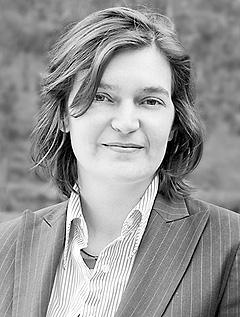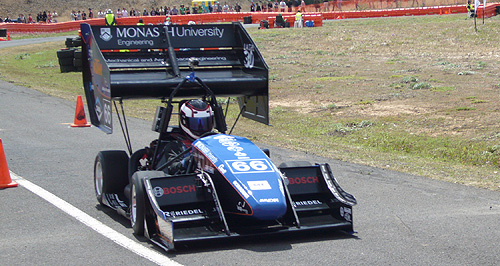News - General NewsSAE-A looks to expand membershipFuture plans: SAE-A executive director Natalie Roberts (below) sees hope beyond Ford and Holden. Auto engineering shines at Formula SAE final despite clouds over the industry17 Dec 2013 By IAN PORTER The Society of Automotive Engineers–Australasia is determined to keep the Formula SAE competition – its largest event – alive and well despite the body blows the industry will suffer when Ford and GM Holden stop manufacturing. The society has already mapped out a plan to expand its membership drive into related areas of engineering when the closures occur in a few years, society executive director Natalie Roberts said on Sunday. She was speaking at the 2013 Formula SAE finals at Werribee, near Melbourne, where Monash University extended its run of consecutive wins with a dominant fifth victory in a row. The win capped a brilliant weekend of competition between 23 university teams which helped offset some of the gloom that had descended on the automotive sector after last week’s news that General Motors would join Ford in ceasing car manufacture in Australia. But Ms Roberts said the society was keen to keep the Formula SAE competition alive because it had achieved so much success in helping students get jobs in the automotive industry and other sectors as well, including motor racing.  Left:SAE-A executive director Natalie Roberts. Left:SAE-A executive director Natalie Roberts.“Today we have great support from the three remaining manufacturers – Mitsubishi used to be a supporter -- because they see these students as being more advanced than some of the students that haven’t competed in this event, so they can pick them up and put them in a more challenging environment immediately,” Ms Roberts said. “Even across this weekend, we have had scouts from various companies coming through and observing the students to see which ones they will make a job offer to or ask to attend an interview.”“We want this event to continue because it is fantastic for the students and really beneficial for the industry.” While many students do get jobs with the three car-makers, others find work in the parts industry and with other companies, many not in the automotive area. “As part of the Formula SAE project, each of the teams has to go out and get sponsorship and these are companies that may not be involved directly in automotive. “Many of the students are getting jobs through their sponsors or the networks they build whilst they are building the car. It may not be through the OEMs (original equipment manufacturers) and automotive directly. “A lot of the students get into motor sport as engineers and race engineers.” The closure of Mitsubishi and the decline in automotive manufacturing volumes generally has seen the society’s membership decline in recent years. This will be aggravated by the Ford and GM Holden factory closures, although Ms Roberts pointed out that the Ford and GM Holden design centres would remain open. She said the society directors had drawn up a plan to bolster membership in coming years. A strategic review of engineering in Australia showed there were several areas the society had not yet addressed with a membership drive, including heavy commercial vehicles. “We are very strong in that in Australia. There are unique Australian truck and trailer combinations requiring local engineering.”“There are also some unique Australian areas like the 4WD off-road aftermarket sector. Australia has got great strength in that, and also trailers and campervans. This is a large growth area in Australia and we do very well in the design and manufacture of those transport and mobility vehicles.” Mr Roberts said the society had already assembled a portfolio of 250 technical training courses that will be made available to members and non-members. Drawn from international sources, principally the SAE International, Ms Roberts said the courses are aimed at people who are already in the engineering field and wants some skills development and additional training. “So there is quality in here, leadership training, project management focused on engineering, and courses covering chassis, body, powertrain, brakes, emissions, electric vehicles, hybrids, the full gamut.” Sunday’s victory was the fifth in a row for Monash, but the first with its newly turbocharged 450cc KTM single cylinder motor. On the track during the endurance test, the technically advanced Monash car, known as the M13, set the fastest time thanks to gains in drivetrain and aerodynamic efficiency over the 2012 car, said the Monash team powertrain leader Chris Groves. Mr Groves said the turbocharger increased power by 25 per cent and torque by 30 per cent yet was using the same amount of fuel. Previous Monash cars have been notable for their giant rear wings, designed with the benefit of time in the university’s wind tunnel. The M13 went a step further, introducing a Formula One-style drag reduction system this year, working on both the front and rear wings. There was plenty of innovation in the other teams, too. The car entered by the University of Western Australia featured some radical aerodynamics with a double-chassis set-up like Colin Chapman’s banned Lotus 88 from 1981. The UWA car has a ground-effect lower chassis mounted direct to the suspension, giving the car its Aerobeam name. The powertrain and driver are carried by a separate chassis mounted to the Aerobeam with leaf springs. Spokesman Andre Van Vulpen said the design does away with conventional springs and shock absorbers. The team was chasing light weight and efficiency through the approach of having fewer parts that do more jobs. The Formula SAE cars are built to a very tight set of rules and are assessed across a wide range of factors, not all to do with the car itself. The cars have to be built within tight budgets, which have to be raised by the teams themselves via sponsorship. The teams also have to do a presentation to a simulated board of directors to demonstrate how the design addressed target market and meets the set design criteria. There are also four dynamic tests, acceleration, skid pad, autocross and a fuel economy/endurance test. The Monash team scored 937.5 points out of a possible 1000. Second was Curtin University from WA on 754.2 points, ahead of University of Melbourne on 685.8 points, University of Adelaide on 664.1 points and the University if WA on 646.1 points with the Aerobeam. The highest placed international team was the University of Waikato in sixth place on 609.1 points. The University of Auckland (13th) was an outright contender right up until the endurance test when it suffered an engine seizure, continuing its run of engine maladies over the last three years. Auckland finished on 472.3 points after scoring none of the 300 points available in the endurance test.  Read more |
Click to shareGeneral News articlesResearch General News Motor industry news |
















Facebook Twitter Instagram